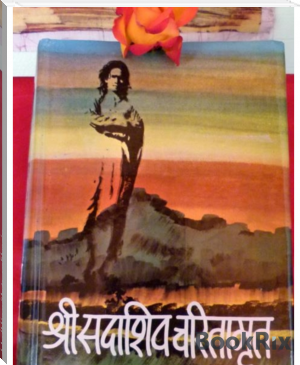Martin Luther King Jr. Day Anthology by - (children's ebooks free online TXT) 📖

- Author: -
- Performer: -
Book online «Martin Luther King Jr. Day Anthology by - (children's ebooks free online TXT) 📖». Author -
She was perfectly overcome by it, and could scarcely restrain the convulsion of tears and sobbings that shook her frame. She hastened home and wrote it, and her husband being away, read it to her two sons of ten and twelve years of age. The little fellows broke out into convulsions of weeping, one of them saying through his sobs, ‘Oh, mamma, slavery is the most cursed thing in the world!’ From that time the story can less be said to have been composed by her than imposed upon her. Scenes, incidents, conversations rushed upon her with a vividness and importunity that would not be denied. The book insisted upon getting itself into being, and would take no denial.”
When two or three chapters were written she wrote to her friend, Dr. Bailey, of Washington, the editor of The National Era, to which she had contributed, that she was planning a story that might run through several numbers of the Era. The story was at once applied for, and thereafter weekly installments were sent on regularly, in spite of all cares and distractions. The installments were mostly written during the morning, on a little desk in a corner of the dining-room of the cottage in Brunswick, subject to all the interruptions of housekeeping, her children bursting into the room continually with the importunity of childhood. But they did not break the spell or destroy her abstraction. With a smile and a word and a motion of the hand she would wave them off, and keep on in her magician’s work. Long afterwards they recalled this, dimly understood at the time, and wondered at her power of concentration. Usually at night the chapters were read to the family, who followed the story with intense feeling. The narrative ran on for nine months, exciting great interest among the limited readers of the Era, and gaining sympathetic words from the anti-slavery people, but without making any wide impression on the public.
We may pause here in the narrative to note two things: the story was not the work of a novice, and it was written out of abundant experience and from an immense mass of accumulated thought and material. Mrs. Stowe was in her fortieth year. She had been using her pen since she was twelve years old, in extensive correspondence, in occasional essays, in short stories and sketches, some of which appeared in a volume called The Mayflower, published in 1843, and for many years her writing for newspapers and periodicals had added appreciably to the small family income.
She was in the maturity of her intellectual powers, she was trained in the art of writing, and she had, as Walter Scott had when he began the Waverley Novels at the age of forty-three, abundant store of materials on which to draw. To be sure, she was on fire with a moral purpose, but she had the dramatic instinct, and she felt that her object would not be reached by writing an abolition tract.
“In shaping her material the author had but one purpose, to show the institution of slavery truly, just as it existed. She had visited in Kentucky; had formed the acquaintance of people who were just, upright, and generous, and yet slaveholders. She had heard their views, and appreciated their situation; she felt that justice required that their difficulties should be recognized and their virtues acknowledged. It was her object to show that the evils of slavery were the inherent evils of a bad system, and not always the fault of those who had become involved in it and were its actual administrators. Then she was convinced that the presentation of slavery alone, in its most dreadful forms, would be a picture of such unrelieved horror and darkness as nobody could be induced to look at. Of set purpose, she sought to light up the darkness by humorous and grotesque episodes, and the presentation of the milder and more amusing phases of slavery, for which her recollection of the never-failing wit and drollery of her former colored friends in Ohio gave her abundant material.”
This is her own account of the process, years after. But it is evident that, whether consciously or unconsciously, she did but follow the inevitable law of all great dramatic creators and true story-tellers since literature began.
For this story Mrs. Stowe received from the Era the sum of three hundred dollars. Before it was finished it attracted the attention of Mr. J. P. Jewett, of Boston, a young and then unknown publisher, who offered to issue it in book form. His offer was accepted, but as the tale ran on he became alarmed at its length, and wrote to the author that she was making the story too long for a one-volume novel; that the subject was unpopular; that people would not willingly hear much about it; that one short volume might possibly sell, but that if it grew to two that might prove a fatal obstacle to its success. Mrs. Stowe replied that she did not make the story, that the story made itself, and that she could not stop it till it was done. The publisher hesitated. It is said that a competent literary critic to whom he submitted it sat up all night with the novel, and then reported, “The story has life in it; it will sell.” Mr. Jewett proposed to Professor Stowe to publish it on half profits if he would share the expenses.
This offer was declined, for the Stowes had no money to advance, and the common royalty of ten per cent on the sales was accepted.
Mrs. Stowe was not interested in this business transaction. She was thinking only of having the book circulated for the effect she had at heart. The intense absorption in the story held her until the virtual end in the death of Uncle Tom, and then it seemed as if the whole vital force had left her. She sank into a profound discouragement. Would this appeal, which she had written with her heart’s blood, go for nothing, as all the prayers and tears and strivings had already gone? When the last proof sheets left her hands, “it seemed to her that there was no hope; that nobody would read, nobody would pity; that this frightful system, which had already pursued its victims into the free States, might at last even threaten them in Canada.” Resolved to leave nothing undone to attract attention to her cause, she wrote letters and ordered copies of her novel sent to men of prominence who had been known for their anti-slavery sympathies,—to Prince Albert, Macaulay, Charles Dickens, Charles Kingsley, and Lord Carlisle. Then she waited for the result.
She had not long to wait. The success of the book was immediate.
Three thousand copies were sold the first day, within a few days ten thousand copies had gone, on the 1st of April a second edition went to press, and thereafter eight presses running day and night were barely able to keep pace with the demand for it. Within a year three hundred thousand copies were sold. No work of fiction ever spread more quickly throughout the reading community or awakened a greater amount of public feeling. It was read by everybody, learned and unlearned, high and low, for it was an appeal to universal human sympathy, and the kindling of this spread the book like wildfire. At first it seemed to go by acclamation. But this was not altogether owing to sympathy with the theme. I believe that it was its power as a novel that carried it largely. The community was generally apathetic when it was not hostile to any real effort to be rid of slavery. This presently appeared. At first there were few dissenting voices from the chorus of praise. But when the effect of the book began to be evident it met with an opposition fiercer and more personal than the great wave of affectionate thankfulness which greeted it at first. The South and the defenders and apologists of slavery everywhere were up in arms. It was denounced in pulpit and in press, and some of the severest things were said of it at the North. The leading religious newspaper of the country, published in New York, declared that it was “anti-Christian.”
Mrs. Stowe was twice astonished: first by its extraordinary sale, and second by the quarter from which the assault on it came. She herself says that her expectations were strikingly different from the facts. “She had painted slaveholders as amiable, generous, and just. She had shown examples among them of the noblest and most beautiful traits of character; had admitted fully their temptations, their perplexities, and their difficulties, so that a friend of hers who had many relatives in the South wrote to her: ‘Your book is going to be the great pacificator; it will unite both North and South.’ Her expectation was that the professed abolitionists would denounce it as altogether too mild in its dealings with slaveholders. To her astonishment, it was the extreme abolitionists who received, and the entire South who rose up against it.”
There is something almost amusing in Mrs. Stowe’s honest expectation that the deadliest blow the system ever suffered should have been received thankfully by those whose traditions, education, and interests were all bound up in it. And yet from her point of view it was not altogether unreasonable. Her blackest villain and most loathsome agent of the system, Legree, was a native of Vermont. All her wrath falls upon the slave-traders, the auctioneers, the public whippers, and the overseers, and all these persons and classes were detested by the Southerners to the point of loathing, and were social outcasts. The slave-traders and the overseers were tolerated as perhaps necessary in the system, but they were never admitted into respectable society.
This feeling Mrs. Stowe regarded as a condemnation of the system.
Pecuniary reward was the last thing that Mrs. Stowe expected for her disinterested labor, but it suits the world’s notion of the fitness of things that this was not altogether wanting. For the millions of copies of Uncle Tom scattered over the world the author could expect nothing, but in her own country her copyright yielded her a moderate return that lifted her out of poverty and enabled her to pursue her philanthropic and literary career. Four months after the publication of the book Professor Stowe was in the publisher’s office, and Mr. Jewett asked him how much he expected to receive. “I hope,” said Professor Stowe, with a whimsical smile, “that it will be enough to buy my wife a silk dress.” The publisher handed him a check for ten thousand dollars.
Before Mrs. Stowe had a response to the letters accompanying the books privately sent to





Comments (0)